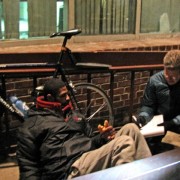Stars and Stripes
/in news/by HomesForHopeWASHINGTON — Veterans Affairs Deputy Secretary Scott Gould had a small army of security, Veterans Affairs staffers and media members as he took to the streets late Thursday night for the annual homeless count.
Officials laughed that the spectacle probably scared away most folks before they could be counted.
But when the group came upon a homeless Marine veteran among a group of vagrants huddled in a Capitol Hill stairwell, it sent the VA staffers into a frenzy.
Gould asked the 54-year-old about his time in the Corps and jotted down his personal information. Staffers started combing through files to see if he was eligible for any benefits. Someone scrambled a van to come out with an emergency shelter team.
A VA spokesman assured reporters that the man would be off the streets within hours.
One down, 62,000 more to go.
Department officials have touted the sharp decrease in veterans homelessness in recent years as a sign of both their focus on the issue and success so far. The number of veterans living on the streets dropped more than 10,000 people from 2009 to 2012, in large part because of department efforts to provide more service and outreach to the destitute veterans.
Gould and other officials freely admit that the task ahead — ending veterans homelessness by the end of 2015, a pledge both the president and VA secretary have publicly made — will be more difficult as they try to engage chronically homeless veterans, many with severe mental illnesses and addictions.
Unlike Thursday, officials won’t be able to reach every one with a full team of VA specialists and media spectators.
The annual point-in-time count has been key to the VA’s efforts on homelessness assistance and prevention. Thousands of volunteers canvassed cities across the country this week, asking men, women and children on the streets how long they’ve been there, why they ended up without a home, and whether they’ve tried to get any government assistance.
The data is combined with head counts at shelters to piece together a full picture of the problem. VA officials have used the figures in recent years to push for more community outreach grants and to expand the Supportive Services for Veteran Families program, which provides resources to keep veterans in their homes before they end up destitute.
Housing and Urban Development Secretary Shaun Donovan said as officials learn more about when and why people end up homeless, they can better react to the problem.
“It’s not just the numbers,” he said. “It’s person by person, family by family, hearing what their stories are so we can tell what they need.”
Michael, the homeless Marine Corps veteran, said he had been living on the streets since 1999. A family dispute, a lost job and a series of health problems left him with little more than a green fatigue jacket and a few other articles of clothing.
He told Gould he wasn’t receiving any VA assistance, but does regularly pick up food stamps. He left details of his military service vague. He smiled when volunteers handed him a donut and some coffee, but started to get agitated when he saw the large group of faces following behind them.
Any veteran can walk into a VA clinic and get a free medical check-up and information on housing resources, Gould said. He didn’t ask Michael why he hasn’t done that.
“Maybe there’s an addiction we don’t see. Maybe he doesn’t trust shelters. Maybe there’s more to the story of a family fight,” he said.
“But for us, it’s about starting to build up trust. We come out here and meet with them. Another volunteer comes out later and checks on how they’re doing. Maybe later we can bring them into a VA hospital, and get him the care he needs.”
Donovan said the 2015 goal to end veteran homelessness and another stated White House goal to end family homelessness by the end of 2020 are still realistic markers. But he also acknowledged that even with a 7 percent one-year decline in the veterans numbers, they aren’t moving fast enough.
Most of the volunteers and VA officials wrapped up their night on the streets around midnight, well before snow began falling in the capital. Official figures from the count won’t be available until late 2013.

